Rocky Horror’s Queer Legacy
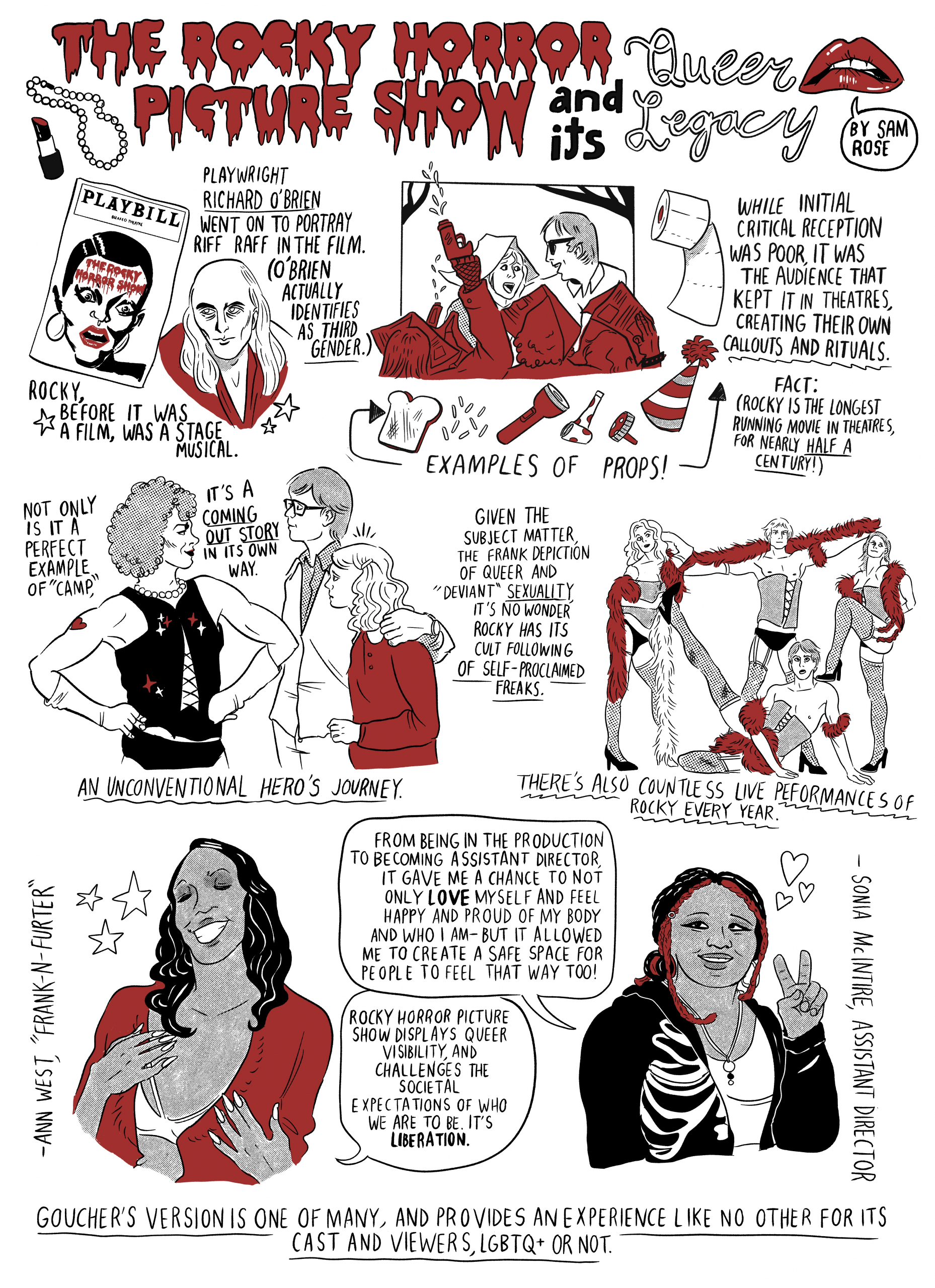
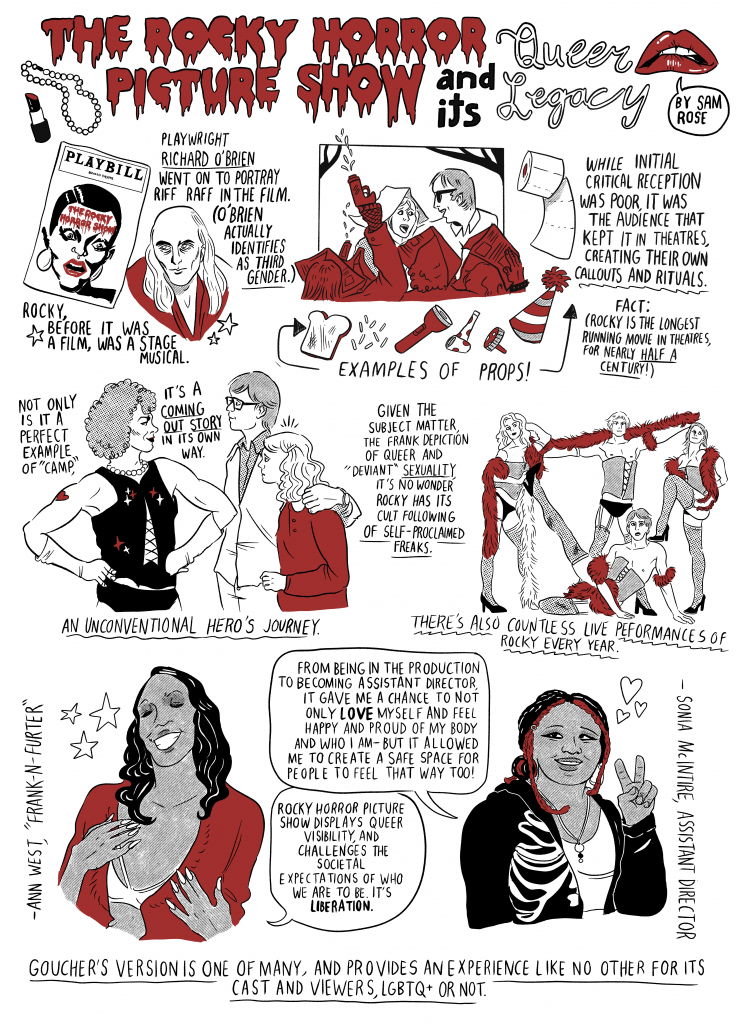



The fall exhibition season for Goucher kicked off last Thursday, September 19th, with the opening of two exhibitions in both

The Repertoire Theater Production course (THE269) has established a new theatrical production, called the Radio Theater. Radio theater is a

By Jamie Nguyen ’25 “Dialogue” and “conversation” has been, is, and very much will be, defining words that we would

Goucher Repertory Dance Ensemble held their fall concert on Friday, November 17 and Saturday, November 18 to close out a successful semester of contemplative choreographic processes.
The curated evening opened with a tap solo created and performed by individualized interdisciplinary major Tess Seibert ‘25 entitled rapt//wrapped in sonder. The piece began with an unexpected entrance from the lobby that captured the audience’s attention instantly, establishing a dramatic tone that was subsequently interrupted by Seibert’s comedic sense of timing.
Next was One Ocean, the preliminary draft of a larger work set by guest artist Gabrielle Lamb on six students this past September. The movement quality was calm yet held tension—a delicious dichotomy with which to execute organic shapes that mimicked ocean waves. Complemented by the voice of naturalist and free-diver Craig Foster, iridescent costumes by Hannah Brill, and soft light washes, the work exuded a meditative ethereality.
Third, faculty member Linda Garofalo was represented by her original work What Lies Dormant. Set on a 13-person cast, this piece was a conflation of the natural cycles of life, death, and rebirth with the four seasons. These themes were accentuated with costumes hand painted by Carter Hinton-Ayodele ‘25 and the use of fake snow in the last segment of the work. Garofalo effortlessly manipulated simple movement vocabulary with her intriguing use of stage space, at one point crafting a geometric formation contained to the right of center, making stage left heavy with emptiness.
After a brief pause in the program came Hands Passing by dance major Nalani Brown ‘26. Driven by the motif of intricate hand gestures, the work set on five dancers was an agonizing inquiry into how isolation affects our communal capacity to heal from it. Viewers were stirred by Brown’s impressive command of visceral empathy and the performers’ emotional commitment.
“Lady” Peaceful, “Lady” Happy was screened penultimately as the only dance film of the night. Triple major Sam Koseff ‘25 with cinematographic assistance from Amelia Lazzini ‘25 created a luxuriously theatric solo to Natasha Richardson’s rendition of Maybe This Time. The piece was recorded in Kraushaar Auditorium with the camera almost exclusively capturing Koseff’s back against the backdrop of row after row of empty seats. Not only did this create an eerie effect as audience members were confronted with the desolate venue they actively occupied, it clearly encapsulated Koseff’s vision of questioning what it means to perform for oneself versus others.
The show was concluded by ingrained…!, a dynamic scrapbook of everything faculty member Mustapha Braimah loves in performance art: movement, spoken word, live drumming, and singing. Backlighting kissed the dancers as they moved from multiple centers of their bodies, creating a strong silhouette of the group performing as one. Ending with the recitation of Mutabaruka’s Dis Poem, this finale challenged the apathy that is too commonly observed in the face of systemic oppression and socio-political injustice.
By Tess Seibert ’25

The fall exhibition season for Goucher kicked off last Thursday, September 19th, with the opening of two exhibitions in both

By Tess Seibert Christopher Law (he/him) has been dancing for around 25 years; he is co-director of DMV artistic collective

By Jaiden Johnson On April 12th, the Kratz Center hosted a reading of Slow Time, a novel written by one
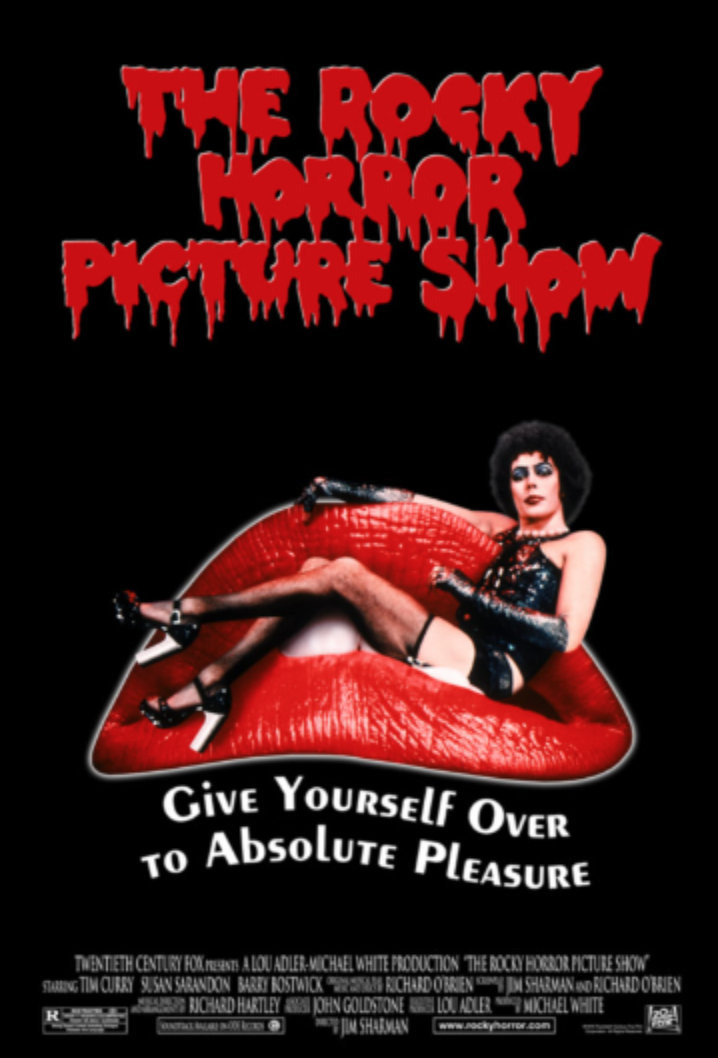
Content warning: Mentions of sexual assault and violations of Title IX
It has been a Halloween tradition for the Open Circle Theatre Club to present the hit musical, Rocky Horror Picture Show. Many students get excited every October to get dolled up and engage with the charming cast as they sing and dance Rocky’s memorable songs. The tradition is not only a fun event that’s filled with music, but it’s also known as a safe space for students, especially LGBTQ+ students to express their sexual and gender identities. The original Rocky musical is known to show strong representation to people that are far from the heteronormative, so Goucher students believe that this student-led event gives them a chance to be proud of their bodies and identities.
However, there has been an issue that has made a major impact on the cast and crew of Rocky Horror. It’s been officially a year since administrative offices have abolished the banlist. The banlist was established to request a ban by cast and crew members to prohibit anyone with sexual harassment allegations to come to the Roocky shows. People can no longer request a ban for people who have records of sexual assault and violated Title IX on campus. The reason given to the directors for the banlist’s removal was a concern that some students have misused it by requesting to ban people from seeing the show for having petty arguments. However, according to Lele Hatcher ‘24, one of the student directors of the show, explains that from what she knows, there wasn’t any sighting of anyone misusing the banlist for that reason. According to the director of last year’s showing, this removal followed the production of the year prior when someone who was on the banlist went to OSE to complain that they were not allowed into the show, and that this list was “unfair”.When the banlist was confirmed for the first time, it led everyone in shock and worry because of the last minute change by the offices. Lele states with confidence that this year will be different and prepared.
Lele confirms, “This year everyone was very understanding, and knew we were trying everything in our power to create a safe space for our cast.”
The directors of Rocky Horror had to attend meetings with the school to discuss how to ensure that the cast and crew members are safe from any audience members who will make them feel uncomfortable. The meetings came to a conclusion that if any Rocky member has a Title IX case, then they would need to report the school about the specific person who has previous, open, or investigated accusations. The members of Rocky also made tactics of making each other feel comfortable and safe while performing.
Wiley ’27 answers that the directors have made it clear that safety is number one priority for everyone who is attending the show. One method of keeping the cast secure is making signals on stage if someone is uncomfortable or if someone is breaking any rules.
Wiley states another method. He says, “We also have a bouncer checking to make sure everyone who attends is a Goucher student, or has special permission.” Wiley is playing the role of Columbia. He and the rest of the cast agree that it’s a fair system.
There is currently no new policy for the audience that makes sure that people will stay safe before, during, and after the show. The directors hope that the audience will hold each other accountable and respect the whole Rocky crew. The bouncers will keep the audience in check as they witness all Goucher students being respectful, since Rocky Horror is known to be a safe space for all queer identities. It should be notified for all attendees that dressing up in sexy attire is not consent, and there will be consequences from the school for people who make people uncomfortable. There are some limitations of who can attend, for the protection of all cast and audience members, while allowing them to feel sexy, comfortable, and hyped for Halloween.
Despite the challenges from the removal of the banlist, the Rocky crew feel confident that the shows will be a success and will continue to satisfy Goucher’s Halloween tradition. From being excited to engage and interact with the audience, to dressing up and feeling confident with their bodies. The directors believe that the process of making the show is going great and the results will be a success.
“Everyone has put in so much work and time,” Lele exclaims, “I hope that audiences will have just as much fun as we do. These changes have not kept our spirits down, and we will continue to come up with new ways to keep our audience and cast safe.”
The cast and crew members have made a welcoming community for each other. They made sure that they all felt like they were a part of the crew. The time and work it takes for them to prepare for the show made people develop a sense of security and confidence.
Wiley expresses his love of the process of Rocky. “We’ve been working on the show for about a month and a half and have come so far. Personally, I’ve never done any dancing for a show before, but the choreography directors were super patient with me and made it very fun!”
The entire theatrical environment made itself a safe space by allowing the people to encourage each other. Everyone believes that the experience of Rocky is the highlight of October, showing that challenges will not make them break down.

Early this semester, a sign was placed in Mary Fisher Dining Hall and in the Student Market alerting students that

Goucher has a problem. Well, it has many problems, but there’s one in particular that I want to talk about

The fall exhibition season for Goucher kicked off last Thursday, September 19th, with the opening of two exhibitions in both

How passionate students of the arts respond to class cancellations, part I
Nalani Brown (any pronouns) is a sophomore dance student pursuing an independent study in choreography instead of taking Composition II, a course that didn’t run as planned this term due to insufficient enrollment.
His group piece draws on an exploration of isolation he did while taking Composition I titled “A Study in Longing” as well as an innovative idea he was excited to flesh out in Composition II: a dance film about the sexualization of the Black body consisting almost exclusively of closeups on dancers’ hands with an occasional torso. He can’t execute his vision exactly as expected, but “it’s so interesting how dynamic hands can be,” he effuses. Though the dance is not restricted solely to hand gestures, the motif provides just enough of a limitation that it challenges Nalani to find new angles to familiar movement vocabulary.
To construct her work, Nalani devises phrases before getting into the studio with her cast. This enables her maximization of the 90-120 minutes per week she gets together with them. She recognizes that the most knowledgeable person about anyone’s body is the individual it belongs to, expressing that if there is a trick someone doesn’t know how to do yet, she invites them to figure it out on their own during rehearsal. She also acknowledges the gravity of pain, promising dancers that if something they attempt in practice hurts, it will not be in the final piece. While this seems like a logical approach to many, pain is often ignored in US concert dance culture. Nalani explains that this more human outlook means dancers are much more willing to try anything at least once without fear that it will be necessary for their participation.
In reflecting on the process, Nalani admits that the scholarly side of dance making demystifies the artform. Rather than being carried in any direction he may fancy, he has qualitative goals he intends to achieve.
“Things have to continue to progress the way that I’ve planned them to a degree, and I think that’s made it easier for me to work as an artist because I also don’t have to live in that nebulous state that many artists live in where you go, ‘Maybe it’s never done.’ I know it’s done when my objective’s been reached and the piece reached the length that I said it would be. It sucks cause it’s adding capitalism into art, but it’s already there… and it may be effective.”
He comments that while this attitude is not romantic, it creates a distance between himself and the work that is beneficial to his mental health; this independent study does not interrupt his sleep like past works have, nor will his soul be at stake when he submits the piece for grading.
Unlike Composition II students, Nalani is not guaranteed a final performance of their work—they are merely conducting research. They will submit their group piece for adjudication to hopefully be viewed in the fall concert this November, and will also contend to represent Goucher at the American College Dance Association conference series in 2024.
By Tess Seibert ’25
Image courtesy of Getty Images

Early this semester, a sign was placed in Mary Fisher Dining Hall and in the Student Market alerting students that

Goucher has a problem. Well, it has many problems, but there’s one in particular that I want to talk about

The fall exhibition season for Goucher kicked off last Thursday, September 19th, with the opening of two exhibitions in both
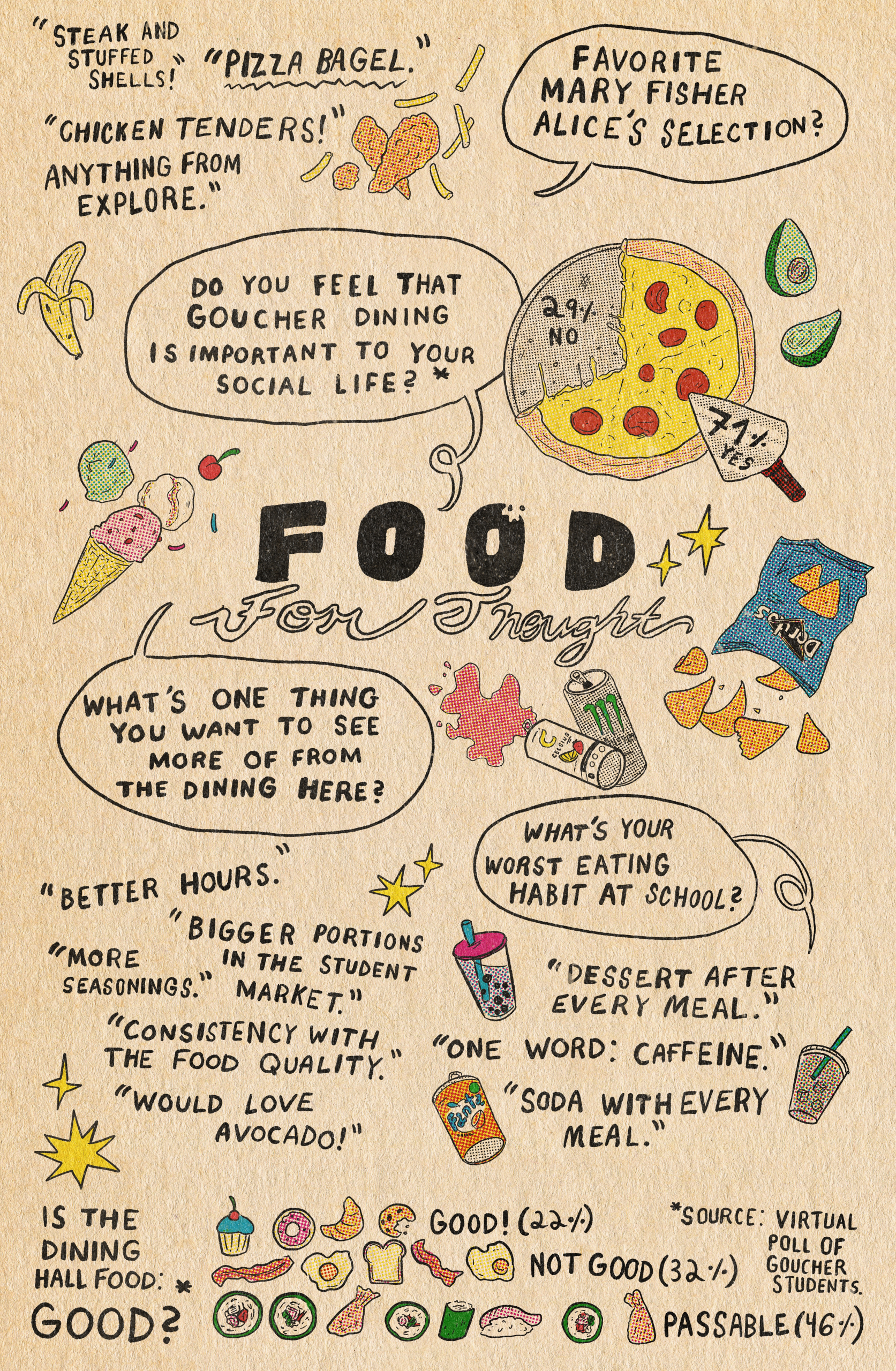
An illustration representing collected quotes from the Goucher student body regarding their dining experience.
By Sam Rose ’26

The fall exhibition season for Goucher kicked off last Thursday, September 19th, with the opening of two exhibitions in both

The Repertoire Theater Production course (THE269) has established a new theatrical production, called the Radio Theater. Radio theater is a

By Jamie Nguyen ’25 “Dialogue” and “conversation” has been, is, and very much will be, defining words that we would
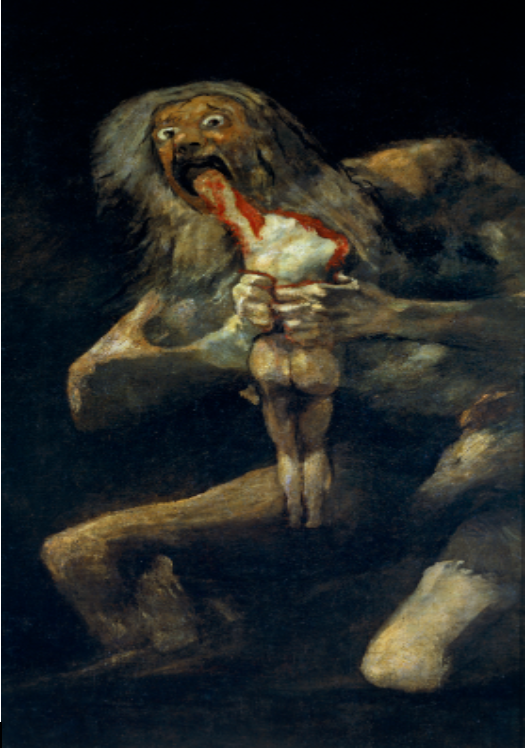
CW: The following work contains graphic descriptions of cannibalism and body horror.
Oh father, what a
Corrupted God you are.
Picked me up like a toy,
And concealed my screams.
Oh father, such a
Hungry God you are.
You stare at my body
With your cold and dead eyes.
Oh father, what an
Ugly titan you are.
With your dry white hair
Your exposed ribcage.
Oh father, don’t you hear
My skull crack?
Blood drips on
Your neck like red wine.
Oh father, you are
A God fueled with rage.
You want to have me as a snack.
All because I wanted to take your throne.
Oh father, what
A mad God you are.
Swallowed my limbless corpse,
I joined with my siblings inside your abyss.

Goucher has a problem. Well, it has many problems, but there’s one in particular that I want to talk about

Hi, we’re Tniya and Aess. Well… yes. This issue’s playlist is a tribute to unrecognized talent, the world famous pop

The following is a poem by Xyn Evans Remember? Of course I do. Everything looked so vibrant and exciting. It
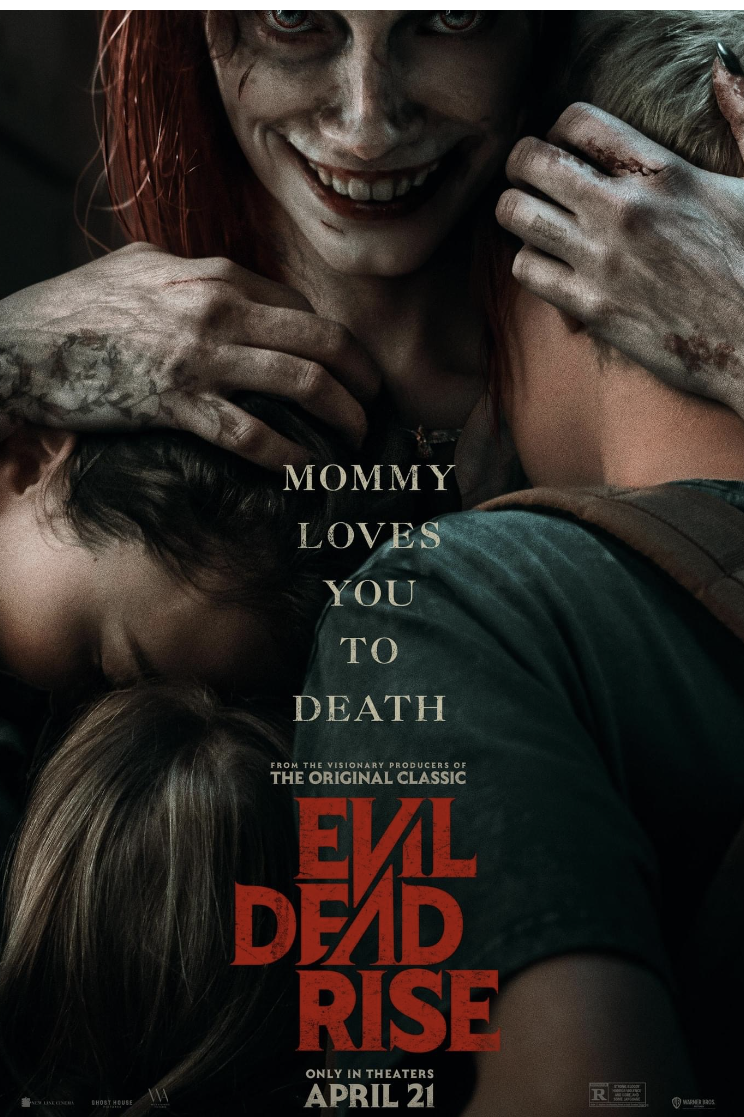
Horror fans know that 2022 was a banner year for the genre, with successful titles like Pearl, Smile, X, Bodies Bodies Bodies, and my personal favorites: Speak No Evil and Incantation. If you’re like me, coming into 2023 the horror we’ve gotten is simply “ok”. While I believe that we still have months to improve for the genre, Evil Dead Rise is a good start.
The film is successful for a few reasons. One being that the performances are very effective, believable and just plain creepy. Part of that is definitely accredited to the writing and director Lee Cronin, but the actors provided stellar (and scary) performances without breaking the small bits of comedy and camp that the original Evil Dead movies are known for.
Alyssa Sutherland kills (literally) in her role as the newly possessed mother Ellie. I will forever be scarred by the kitchen scene delivered by Gabrielle Echols as Bridgette. Also, I am forever appreciative of the casting team for giving us Nell Fisher as Cassie – child actors are always hit or miss in movies with this tone (looking at you, Sinister) but Fisher’s performance was realistic, tense and at times extremely heartwarming.
The film is also successful because of its clever use of practical and VFX, the blend between the two is so seamless, that the gore looks almost too good. Some horror viewers may overlook the cinematography and score for Evil Dead Rise but both add to the eerie ambiance of the plot, the movie tells us exactly what to feel even when not much is going on. There’s a certain self awareness to Evil Dead Rise that a lot of fans will appreciate, aside from the overall “Sam Raiminess” of it all, the special nods to previous Evil Dead movies and even The Shining were a nice subtle touch.
As far as plot, what I can appreciate about this movie is that it gives us someone flawed to root for. It also pushes the themes of daily relationships and motherhood in the relationships between Ellie and her children, and later Beth (Lily Sullivan) and Cassie when we find out that Beth is pregnant. This surprisingly doesn’t feel like a trope, and by the end we’re rooting for the final girls as a family.
My biggest gripe is with Dani’s character, played by Morgan Davies. While I celebrate having queer coded characters do something other than exist to be queer in this movie, I wish Dani was just a more intelligent character. Dani’s discovery is the most trope-reliant part of the movie for me. This entire plot would cease to exist if Dani would have simply minded their business or practiced safe behaviors, which they are completely capable of making practical decisions later on in the film.
Ultimately, Evil Dead Rise is a solid film. It’s short run time gives watchers the perfect afternoon scare while being thoroughly packed with action, kills, and emotion. It’s sitting at around a 3.5/5 on Letterboxd as of publishing, and an 84% on Rotten Tomatoes, although these are respectable ratings from the theater audiences, you could stand to watch it at home if it hits streaming as well.

Goucher has a problem. Well, it has many problems, but there’s one in particular that I want to talk about

The fall exhibition season for Goucher kicked off last Thursday, September 19th, with the opening of two exhibitions in both

By Jaiden Johnson On April 12th, the Kratz Center hosted a reading of Slow Time, a novel written by one
This April the Walters Art Museum of Baltimore debuted their new exhibit, Across Asia: Arts of Asia and the Islamic World. The exhibition features three new galleries, each focused on a different region: East Asia, South and Southeast Asia, and the Islamic World. Containing over 600 works that span over 5,000 years, Across Asia is the result of years of work from curators, museum staff, museum supporters, and more recently, the Walters’s new College Student Advisory Group (CSAG).
Containing twelve college students from five Maryland campuses, the College Student Advisory’s Group’s main goal is to bring a fresh, youthful perspective to a field that is typically dominated by older experts and academics. Two Goucher students, Amy Kornberg ‘25 and Bronwyn Burke ‘24, served on the advisory group, which was tasked with developing Community Voice labels for specific objects and planning the College Takeover, a community event at the Walters. Both Kornberg and Burke found out about the opportunity through professors at Goucher, who encouraged them to apply.
“Since I’m an Asian Studies minor, I thought that it would be interesting to learn about different [Asian] arts and artforms, and engage with that. And the application process was fairly easy,” Kornberg noted.
“I’m from the city, so I grew up going to the Walters Museum. I’ve been there probably a hundred times, and I’m not being sarcastic when I say that that,” Burke said, “so I was like, ‘yes, this is what I want to do.’”
Peter Ibenana, the David Hischorn Head of Community Engagement at the Walters Museum, had the idea for CSAG. “The Walters is really working to bring in more community perspectives and community voices to its exhibitions and installations, but [college students were] not identified at the time,” Ibenana said, speaking to the original inspiration that led to the group’s formation.
The students in the group were contracted for 6 two-hour meetings, the first three of which pertained to Community Voice labels, with the second three being focused on organizing community events. The College Takeover – the event the group organized – featured different community engagement methods, including a zine created by the group, a photo booth, and a button-making activity. For the Community Voice labels, group members teamed up and picked certain objects in the exhibit to write about from a college student perspective.
Kornberg’s group wrote about an ancient scholar’s desk from the East Asian gallery, and Burke wrote with one other student about a case of ivory statues depicting Jesus Christ from the South and Southeast Asian gallery. Kornberg said that the process of writing was “hard, but it was cool, because we got to hear each other’s stories, and how they connected to the object, and kind of meld them into one. It was hard though, because everyone has such different stories.”
Burke agreed with Kornberg on the difficulty of the task: “the process initially was very difficult because [my group partner] and I have very different backgrounds. Trying to synthesize our voices into one… was difficult, but rewarding in the end when we came up with the final project,” she said. “We could still be in touch with our own experiences, but it worked well together.”
Burke and Kornberg both felt like the experience of being on CSAG taught them a lot, even if they do not envision themselves working in the field as a career, as is true for Kornberg. “I think that working with other people, that was a good life lesson for me personally, because I’m such an introvert, so talking to other people is hard. Being kind of forced to talk to them gave me an outlet to say ideas and opinions,” she said.
As a history major with a minor in historic preservation and visual material culture, museum work is right up Burke’s alley. “I learned more about just how long it takes to put an exhibit together, the process, and sort of the background of a museum… I plan on going into library sciences and archival work, so this is already on the horizon [for me],” she said.
Ibenana’s takeaway from the College Student Advisory Group shows a rich vision for the next generation of museum curators. “If there’s anything I would want [CSAG] to take away, [it would be] to not just reimagine not just museums, but understand how spaces can be hubs for collaboration and engagement” Ibenana explained.
He acknowledged that while the Walters Museum is looking to make some changes with additions like CSAG, there is only so much that can be done with a traditional museum that is nearly one-hundred years old. Nevertheless, he hopes that bringing young perspectives to a space like the Walters will not only spark change within the institution, but that it will inspire the next generation to truly think outside of the box.
“What I would want them to do is not to come in and become carbon copies of us,” he said, “But to come in, learn some things, and do something different in your time. Do something completely different. Do something that doesn’t look the same as this, because that’s what’s going to bring in a lot more people to have conversations about these things.”
The Walters Art Museum’s Across Asia: Arts of Asia and the Islamic World is free and open to the public. The galleries span the entire fourth floor of the museum, with a small exterior section dedicated to contemporary Asian artists. The Walters Art Museum is open Wednesday, Friday, Saturday, and Sunday from 10 a.m. to 5 p.m., and Thursday from 1 p.m. to 8 p.m.
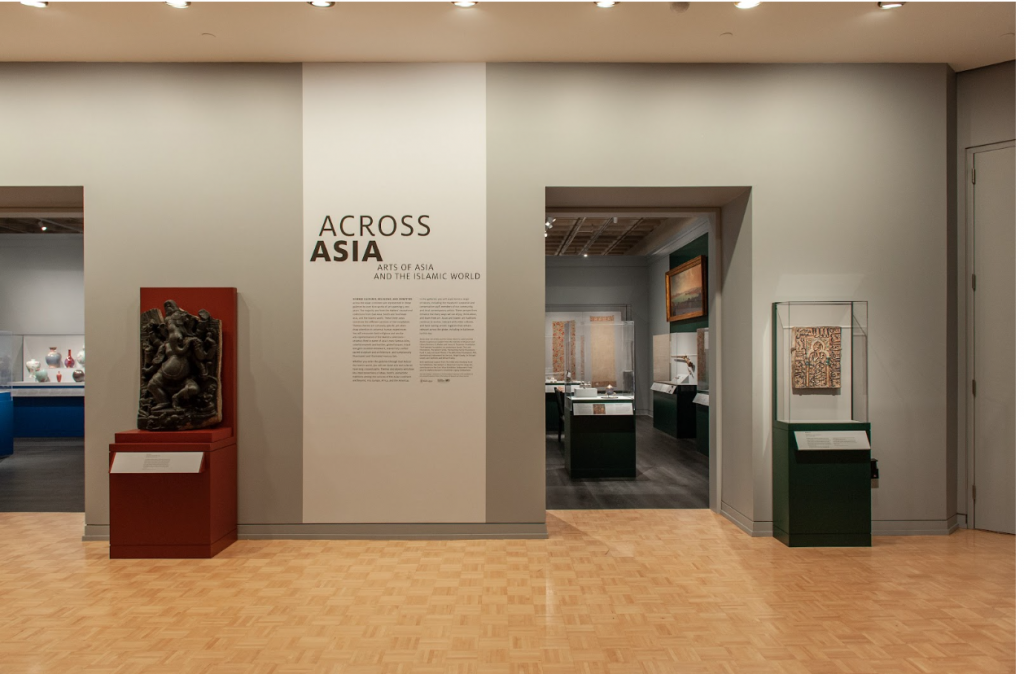
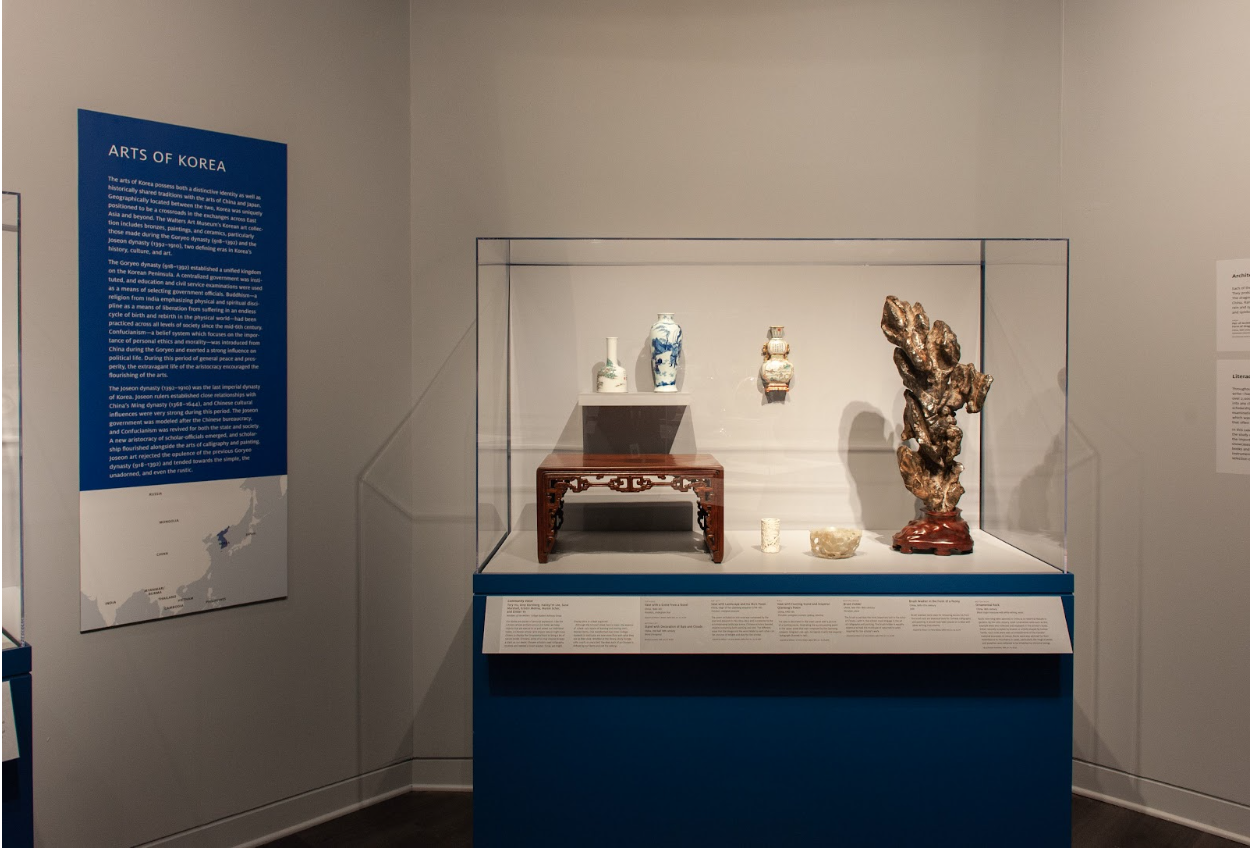

The fall exhibition season for Goucher kicked off last Thursday, September 19th, with the opening of two exhibitions in both

By Jaiden Johnson On April 12th, the Kratz Center hosted a reading of Slow Time, a novel written by one

The Repertoire Theater Production course (THE269) has established a new theatrical production, called the Radio Theater. Radio theater is a
On Friday, April 21, Kraushaar Auditorium and the Dorsey Center filled with families, students, and movement. The Goucher Repertory Dance Ensemble Spring Concert held that weekend featured a variety of different art that showcased the talent and technique of the Goucher Dance Department.
The show, which consisted of six performances, featured compositions from both Goucher students and visiting artists. The show was not limited to live media and also included the dance film Flow: Cherished moments in movement by Halley Price ‘23.
Artist Rosie Herrera’s piece started off the show. It was a creative insight into the minds of the dancers as they were given the chance to shape the piece around their own expression. In the second act, choreographer Maurice Brandon Curry’s dance arrangement A Classical Gas played with the traditional conventions of ballet and had some fun with it. Curry’s composition, backed by Vivaldi and Yo-Yo Ma, had dancers in tux inspired costumes show off their ballet skills and their theatrical senses of humor. Which included confetti, shouting, and bee stings. He dedicated it to the dancers who brought it to life.
Leah Gabrielle ‘23 presented A Choreopoem for the Angry black women stuck in Time; being black while hiding why I am angry, which she wrote and choreographed. This stand out piece presented Gabrielle performing her poetry while dancers moved in rhythm on stage. The piece was artfully moving and with the intermission immediately following, it inspired much conversation in the audience.
Gabrielle explained in the program,“I want to show not just the pain and progress but the joy that is found when we choose to see the world in front of us and the perceptions of those who don’t understand us and maybe never will.” The last poem which places Gabrielle alone wrapped in gold addressing the audience directly was particularly brilliant and bold. “This is for the Black women who have never felt understood; it is for the angry Black women they have made us out to be.”
Sam Koseff’s ‘25 composition The Fool features a dynamic and emotional performance from Laura Juda ‘23, Emma McAlpine ‘23, and Willa O’Connor ‘26. The piece, set to the music standard “Send in the Clowns, is a moody and visually masterful work–and a wonderful and captivating choreographic debut for the sophomore artist.
As an explosive finish to the showcase, Je ne sais quoi by Mustapha Braimah beautifully and joyfully celebrated the roots and innovation of African dance. The largest piece in the show, the dancers each wore unique custom costumes by a Ghanaian seamstress making the stage an all out celebration of movement and color. Braimah wrote in the program that the piece, “reflects the conscience and legacies that we’re all a part of and the universal journey that each person takes to find – and share– their passion.” Goucher is one of a select number of schools in North America that requires proficiency in West African dance, and the dancers displayed far more than simply proficiency when they brought Braimah’s choreography to life.
Creativity and expression is at the heart of Goucher, and the students in the dance department are cultivating a community that encourages unique and meaningful experiences. Next time you have an opportunity to watch a show, take it, it will definitely be worth your time.
By Athena Perry ’26

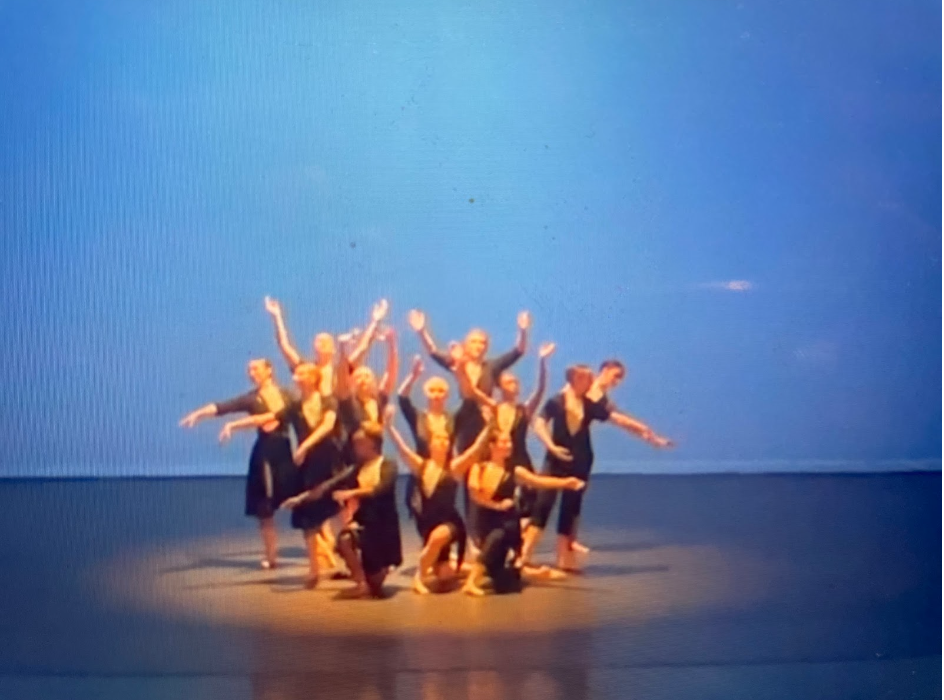

The fall exhibition season for Goucher kicked off last Thursday, September 19th, with the opening of two exhibitions in both

By Jaiden Johnson On April 12th, the Kratz Center hosted a reading of Slow Time, a novel written by one

By Tess Seibert Christopher Law (he/him) has been dancing for around 25 years; he is co-director of DMV artistic collective
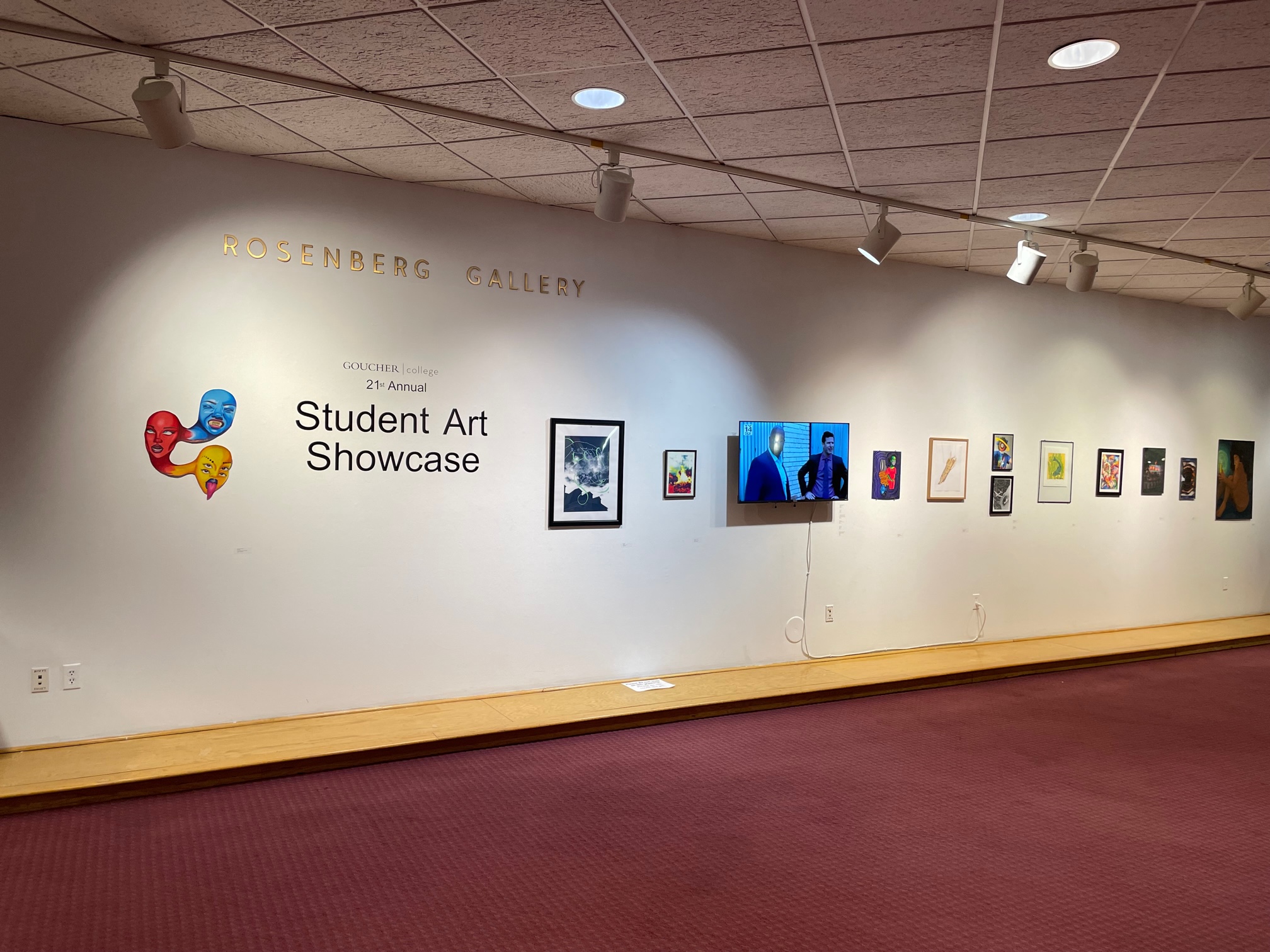
The 21st-Annual Goucher College Student Art Showcase debuted this week in the Rosenberg Gallery, displaying the hard work and endless creativity of the Goucher College studentry. From silent films to stained glass, the new exhibit contains a wide range of mediums, both traditional and nontraditional. With 75 artists featured, this year’s showcase is an extensive look at the diverse and exciting culture of artistic expression at Goucher.
Upon entering the exhibit, viewers are greeted by a vibrantly-colored, three-headed humanoid creature floating next to the gallery title, a pencil on paper illustration by Shahadah Tobias. The three heads each don a different expression, a fitting introduction to the wide array of emotions that onlookers will experience while walking through the showcase. On the same wall is a television monitor that loops through six different student films, including the aforementioned silent film, as well as music videos, animations, and an overdubbed scene from the FOX comedy series Brooklyn Nine-Nine (a piece that is much better seen in person than described in writing).
The rest of the showcase does not fail to impress, with highlights such as the photorealistic watercolor paintings of Hannah Kraenbring, the wearable cloth works by Robert Graham and Bel Rosenthal, and the handmade Scooby Doo and KAWS rugs by Mark Martin.
Of course, this is only scratching the surface of the talent exhibited in this year’s showcase. To cover all of it in one article would not only take pages and pages, but it would also do a disservice to the artists whose work should be seen in person to truly appreciate and experience it. If you want to support Goucher students, seeing this year’s Student Art Showcase is a must. It not only gives one an opportunity to see their peers’ hard work on display, but it also promotes the artistic culture of Goucher College that made it the school it is today. Those are causes that are always worth supporting.
The Open Reception for the 21st Annual Student Art Showcase is Thursday, April 27th from 6-8pm. Over 100 students submitted work, which was first judged by Goucher’s Studio Art faculty. Baltimore based artist and educator Christina McCleary is this year’s juror who will award the first, second, and third place prizes. You can find the showcase in the Rosenberg Gallery in the Dorsey College Center.
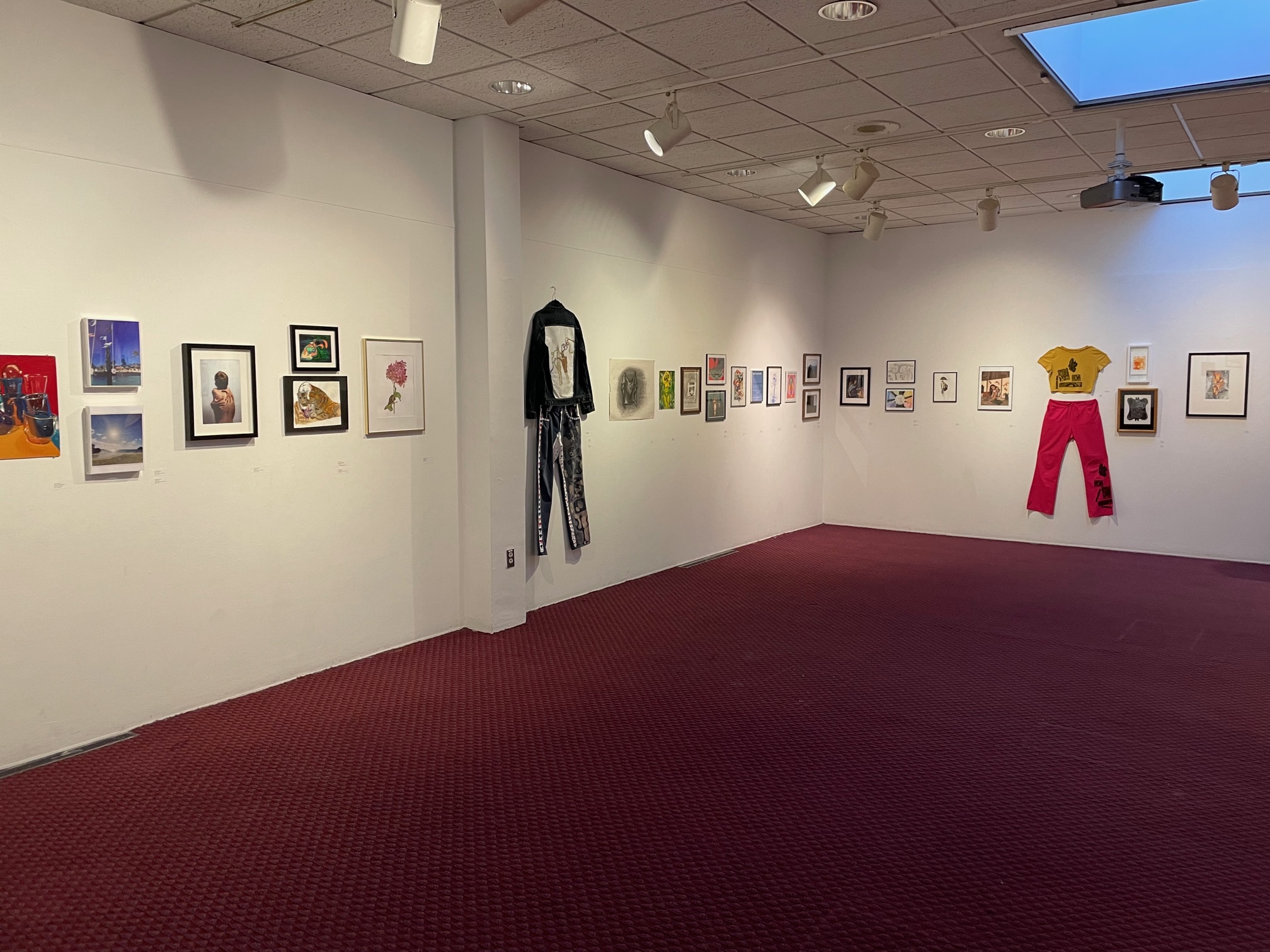
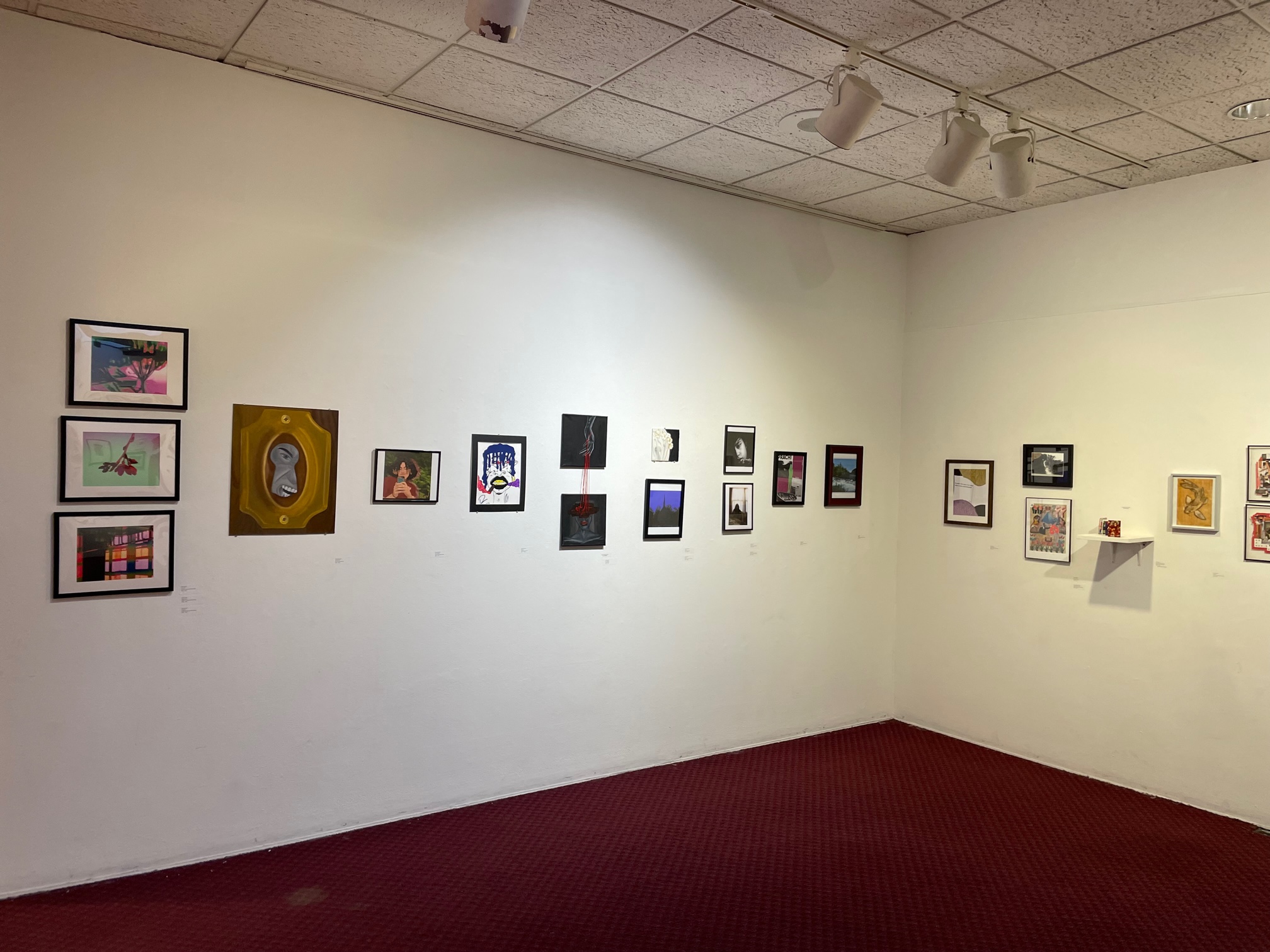

The fall exhibition season for Goucher kicked off last Thursday, September 19th, with the opening of two exhibitions in both

By Jaiden Johnson On April 12th, the Kratz Center hosted a reading of Slow Time, a novel written by one

The Repertoire Theater Production course (THE269) has established a new theatrical production, called the Radio Theater. Radio theater is a
